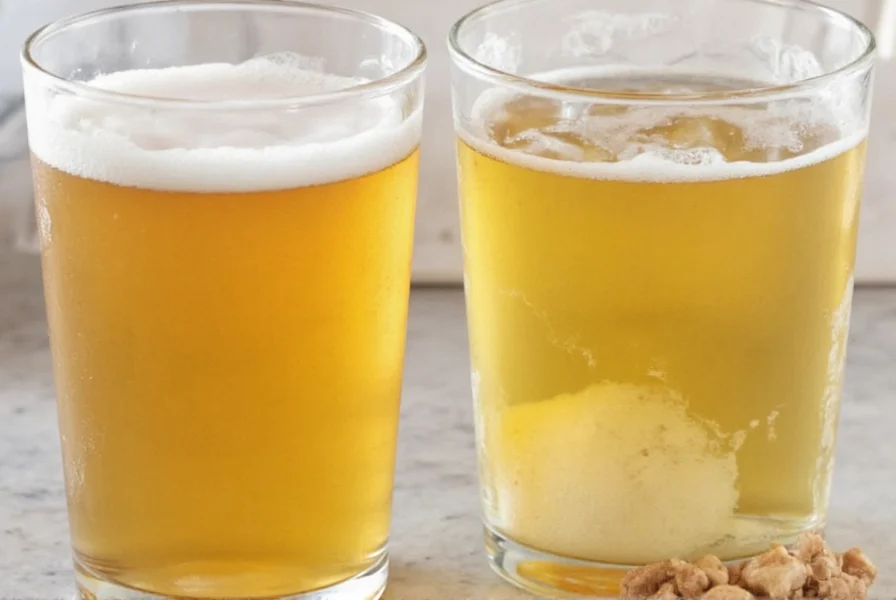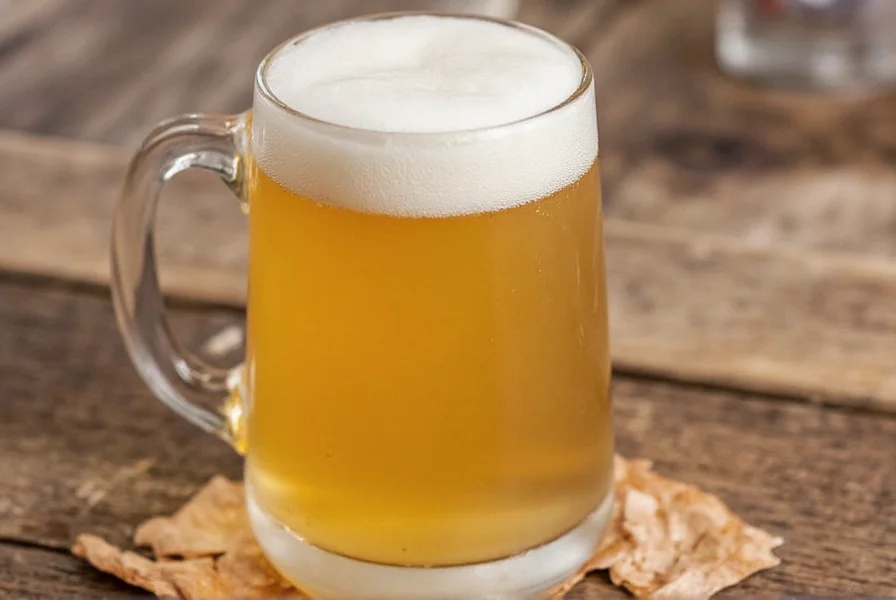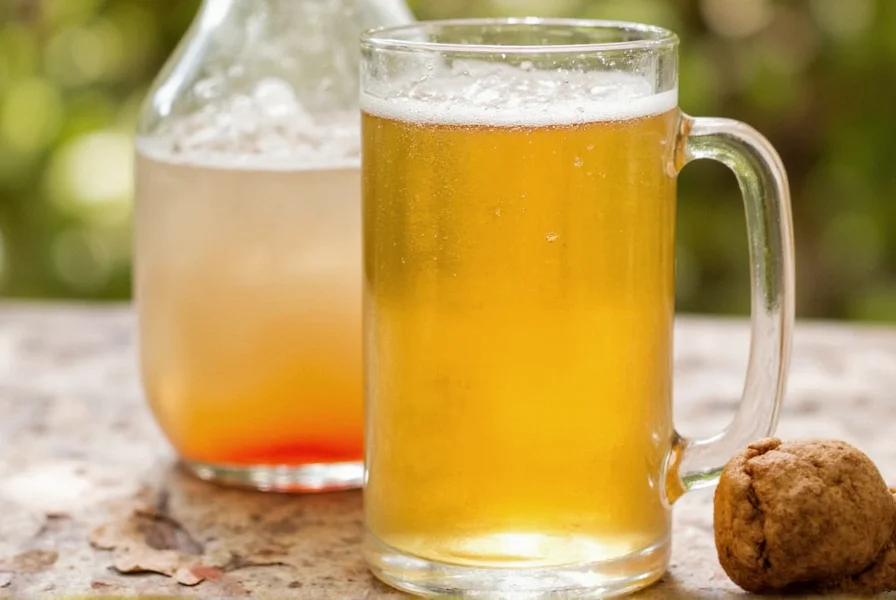Homemade ginger beer is a naturally carbonated, refreshing beverage made through fermentation of fresh ginger, sugar, water, and a starter culture. The basic process involves creating a ginger bug starter (or using commercial yeast), preparing a ginger syrup, combining ingredients, and allowing controlled fermentation for 3-7 days. Proper bottling in swing-top bottles is crucial for safety, as pressure builds during carbonation. The final product typically contains 0.5-2% alcohol naturally, though non-alcoholic versions can be made with shorter fermentation. Total preparation time is approximately 15 minutes with 3-10 days of fermentation.
Making ginger beer at home connects you with a centuries-old tradition of natural fermentation. Unlike commercial versions that often contain artificial flavors and preservatives, homemade ginger beer offers vibrant, spicy flavor and the satisfaction of crafting your own probiotic-rich beverage. This guide provides everything you need to create perfect ginger beer safely and consistently, whether you're a complete beginner or looking to refine your technique.
Understanding Ginger Beer Ingredients
The quality of your ginger beer depends entirely on the ingredients you select. Let's examine each component's role in creating the perfect homemade ginger beer recipe.
Fresh Ginger Root: The Heart of Your Brew
Choose young, firm ginger with smooth skin and no wrinkles. Older ginger becomes fibrous and less flavorful. For a standard 1-gallon batch, you'll need 1 cup of freshly grated ginger (about 4-6 ounces). The ginger's volatile oils provide the characteristic spicy kick, while its natural enzymes aid fermentation. Many home brewers wonder how to make ginger beer without the strong ginger bite—simply reduce the amount or use slightly older ginger, which has milder flavor compounds.

Sugar Selection Matters More Than You Think
Sugar isn't just for sweetness—it feeds the fermentation process. While white sugar works perfectly, many crafters prefer alternatives:
| Sugar Type | Flavor Profile | Fermentation Speed | Best For |
|---|---|---|---|
| White Cane Sugar | Neutral | Fast | Traditional ginger beer |
| Molasses | Rich, complex | Moderate | Dark ginger beer |
| Maple Syrup | Earthy, woody | Slow | Subtle flavored batches |
| Honey | Floral notes | Variable | Mead-inspired ginger beer |
Water Quality: The Silent Ingredient
Tap water with chlorine will inhibit fermentation. Always use filtered or spring water, or boil tap water for 15 minutes and cool before use. The minerals in spring water actually enhance the fermentation process for better homemade ginger beer.
Essential Equipment for Safe Ginger Beer Making
While you don't need specialized equipment, certain items ensure safety and consistency in your ginger beer without yeast experiments:
- Non-reactive pot: Stainless steel or enamel-coated (avoid aluminum)
- Fine mesh strainer: For removing ginger pulp
- Swing-top bottles: Essential for safely containing carbonation pressure
- Plastic funnel: For clean bottling
- Measuring cups and spoons: Precision matters in fermentation
- Thermometer: Critical for temperature-controlled fermentation
Never use regular glass bottles or plastic soda bottles—they can explode under pressure. Swing-top bottles (like Grolsch-style) are designed to release excess pressure safely, making them perfect for traditional ginger beer fermentation.
Step-by-Step Ginger Beer Brewing Process
Creating Your Starter Culture
For authentic homemade ginger beer, create a ginger bug starter 5-7 days before brewing:
- Day 1: Combine 2 tablespoons grated ginger, 2 tablespoons sugar, and 1 cup filtered water in a clean jar
- Cover with cheesecloth and secure with rubber band
- Days 2-5: Add 1 tablespoon grated ginger and 1 tablespoon sugar daily
- When bubbly and slightly foamy (usually day 5-7), your starter is ready
This natural starter contains wild yeast and bacteria that create complex flavors in your ginger beer without commercial yeast. If you're wondering how to make ginger beer faster, you can substitute 1/4 teaspoon champagne yeast, but the flavor profile will be less complex.
Brewing the Ginger Beer
- Prepare ginger syrup: Simmer 1 cup grated ginger and 1.5 cups sugar in 4 cups water for 15 minutes
- Cool completely: Bring to room temperature (critical for healthy fermentation)
- Combine: Mix cooled syrup with 6 cups filtered water and your ginger bug (or yeast)
- First fermentation: Cover with breathable cloth and ferment at 68-75°F for 3-5 days
- Bottle: Strain into swing-top bottles, leaving 1.5 inches headspace
- Second fermentation: Store bottles at room temperature for 1-3 days to carbonate
- Refrigerate: Chill for 12+ hours to slow fermentation before opening
Safety Considerations for Home Fermentation
Understanding how long does ginger beer ferment safely is crucial. Over-fermentation causes dangerous pressure buildup. Follow these safety guidelines:
- Always use proper fermentation-safe bottles
- "Burp" bottles daily during second fermentation by slightly opening the cap
- Store bottles in a cardboard box or plastic container to contain potential explosions
- Refrigerate after carbonation to prevent over-pressurization
- Discard if mold appears on surface (pink, black, or fuzzy growth)
The natural alcohol content in traditionally fermented ginger beer ranges from 0.5-2%, depending on fermentation time. For how to make non-alcoholic ginger beer, limit second fermentation to 24 hours and refrigerate immediately.
Troubleshooting Common Ginger Beer Problems
Flat Ginger Beer
Cause: Insufficient sugar, low temperature, or dead starter
Solution: Add 1 teaspoon sugar per bottle before second fermentation and ensure temperature stays above 65°F
Overly Sour Flavor
Cause: Over-fermentation or contaminated starter
Solution: Shorten fermentation time and maintain cleaner equipment for future batches
Bottle Explosions
Cause: Too much sugar, warm storage, or improper bottles
Solution: Always use proper bottles, refrigerate after carbonation, and "burp" daily during second fermentation
Delicious Variations to Try
Once you've mastered the basic homemade ginger beer recipe, experiment with these flavor enhancements:
- Lemon-Ginger: Add zest of 2 lemons during syrup preparation
- Ginger-Lemongrass: Simmer 2 stalks lemongrass with ginger
- Spiced Ginger Beer: Add cinnamon stick, cloves, and star anise during simmering
- Fruit-Infused: Add 1/2 cup mashed berries during second fermentation
For those exploring ginger beer without yeast options, the ginger bug method described above creates natural carbonation through wild fermentation—no commercial yeast required.
Storing and Serving Your Homemade Ginger Beer
Properly stored in the refrigerator, homemade ginger beer stays fresh for 3-4 weeks. Always open bottles over a sink, as pressure buildup may cause foaming. Serve chilled in tall glasses, optionally with a squeeze of fresh lime. The natural sediment at the bottom is harmless—gently swirl bottles before opening to distribute it.
For the best flavor development, allow your ginger beer to condition in the refrigerator for at least 3 days before consumption. This maturation period lets the flavors meld and creates smoother carbonation.












 浙公网安备
33010002000092号
浙公网安备
33010002000092号 浙B2-20120091-4
浙B2-20120091-4